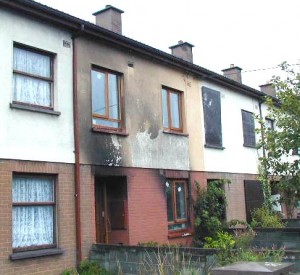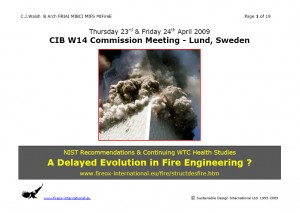2009-06-08: The other day, I received an impassioned e-mail … an extract …
” We are an energy rating company involved in a campaign for enforcement. Yesterday, we made a presentation to SEI (see attached). It was the result of a 2-month attempt to meet with the DEHLG and SEI. You are right in your article about them ‘not WANTING to know’.
My only question is: do you have any ideas on what’s next ? ”
The BER Gold Rush Soap Opera so far …
There are thousands of BER Assessors out there around the country … each having paid a ‘pretty penny’ for training, for exams, and for registration … and work on the ground is very scarce. A significant number of those Assessors have an inadequate understanding of building construction … while some of the people who are involved in providing Validated BER Training Courses are, to put it mildly, similarly unendowed.
Energy Ireland (SEI) is the Issuing Authority, but it has absolutely no experience as a Control Authority. And has anyone bothered to read the relevant Legal Disclaimer on the SEI WebSite ? It does, however, have a large marketing budget … those smarmy, wall-to-wall radio advertisements, which refer to the ‘property game’, continue to irritate my sensitive ear drums !
Apparently … 20% of BER Assessments are turning out to be faulty, i.e. they have not been properly carried out by Registered BER Assessors. In other words, 1 out of every 5 BER Certificates needs to be thrown in the paper recycling bin. Furthermore … I have discussed in one of my first posts how there is only a very tenuous relationship between a BER Certificate and the ‘real’ energy performance of a specific building. And in relation to ‘real’ buildings … there is a general non-compliance rate of 70% on Irish Building Sites with the minimal energy performance requirements in Part L of the Irish Building Regulations.
SEI’s Register of BER Assessors is unreliable.
What a magnificent waste of time, energy and money !
Some Comments on a Recent BER Certificate …
Sitting on the desk to the left of my computer keyboard is a recent Building Energy Rating (BER) Certificate and its accompanying Advisory Report … issued sometime during the second half of May 2009 … for a private, single-occupation dwelling house somewhere in Leinster … and using the DEAP Version 3.0.0 computer software. I do not wish to identify the specific Certificate.
This particular BER Certificate Documentation comprises:
– the actual BER Certificate ;
Can I be sure that the correct choices were made with regard to the software input information/data ? No.
– its accompanying BER Advisory Report.
Not missing any marketing trick, and in stark contrast to the actual BER Certificate … there is an Energy Ireland (SEI) Logo at the top of the first page of the Advisory Report … and an elaborate footer with SEI contact information on the last page.
Meanwhile, there is not one single mention of Statutory Instrument No. 666 of 2006: European Communities (Energy Performance of Buildings) Regulations 2006 anywhere in the Report … nothing to explain that SEI is the Issuing Authority for the purposes of this national legislation … or that there is such a thing as a BER Register … etc, etc, etc.
The Advisory Information provided in the Report is too vague to be useable … and there are silly typographical errors.
Did the BER Assessor request any information from the owner about the house ? It is impossible to tell whether he/she made any such request.
Am I assured that the BER Assessor had an adequate understanding of building construction ? Definitely not.
[ Specific comments about other issues might identify the actual BER Certificate. ]
What’s Next ?
The following remarks are directed at those BER Assessors, building owners, landlords, building professionals and general punters who do wish to spend their money on something worthwhile … something which has meaning, and is useful.
Energy Labelling of Buildings, just as in the case of other energy using/consuming industrial products … is positive and very worthwhile.
The legal basis established by European Union (EU) Directive 2002/91/EC of the European Parliament and of the Council, of 16 December 2002, on the Energy Performance of Buildings … is a good start.
I would much prefer if this Directive were linked in more directly to the Extensive Framework of the Construction Product Directive … EU Council Directive 89/106/EEC, of 21 December 1988, on the Approximation of Laws, Regulations and Administrative Provisions of the Member States relating to Construction Products. The reason that this has not already happened is because of a startling lack of horizontal integration between the different Directorates-General in the European Commission.
If there are problems with how the BER Legislation is operating at national level in Ireland, it is not the fault of Brussels or Directive 2002/91/EC … it is our problem … and it is up to us to remedy the situation.
There are 3 Immediate Priorities for Building Energy Rating in Ireland:
– increase accuracy ;
– reduce uncertainty ;
– improve reliability.
An Initial Proposal …
Without amending any legislation … and without reference to the Department of the Environment, Heritage & Local Government (DEHLG), Energy Ireland (SEI) and the Construction Industry Federation (CIF) … none of which have shown any proper leadership in relation to these issues, but seem interested only in playing games …
1. The BER Certificate
Attach a Single-Page Appendix to the actual BER Certificate which clearly shows the Input Information/Data selected by the Registered BER Assessor. Include a Statement of Measurement/Calculation Uncertainty concerning the Energy Rating Process … and a Statement of Competence in Building Construction, with the Assessor’s Signature … at the bottom of the page.
Show the Page Number on the Certificate as Page No.1 of 2 … and on the Appendix as Page No.2 of 2.
A BER Certificate should not be valid without this Appendix.
2. The Accompanying BER Advisory Report
Generally … tighten up the information provided in the Report, make it easier to understand … and make it more useable ! DO NOT TIE energy performance, or any other aspects of building performance, to the minimal – ‘abysmal’ – performance targets described in the guidance texts of Technical Guidance Documents A-M in the Irish Building Regulations. We have to aim much, much higher !! The European Union’s 2020 Climate Change Targets will be heavy going for Ireland, even if there is no agreement in Copenhagen at the end of 2009. And … insert Page Numbers !!!
Include Additional Components in the BER Advisory Report:
– Findings of a Formal Interview/Questionnaire Survey with the building owner, landlord or manager – some questions should have an open format ;
– Results of Infra-Red Thermography and Air Seepage Testing – discussed at length in previous posts ;
– Results of a Radon Test – as already discussed, an important indicator of Indoor Air Quality and whether or not there is adequate Ventilation in the building.
.
.
END











